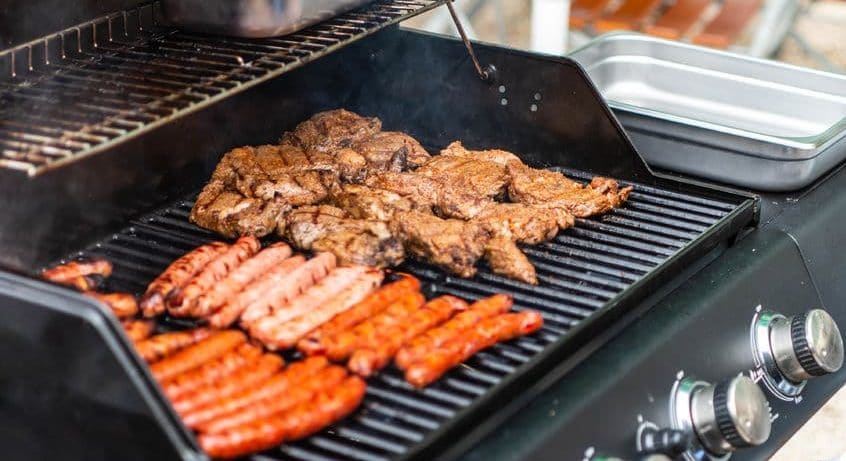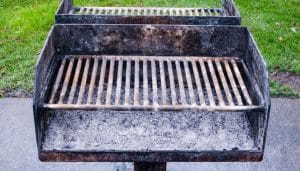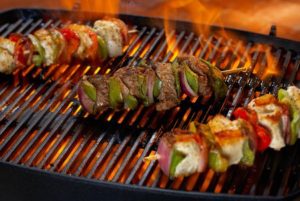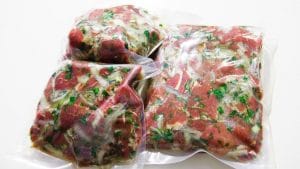Being brand new to grilling can be overwhelming. Extreme heat, gas, huge flare-ups, it can seem intimidating. If you are starting on a gas grill you already have a step above the competition, gas is perfect for beginners and is a great step into grilling in general. This beginner’s guide to gas grilling will help you get started on the right foot!
Grilling is very easy to learn if you feel you need assistance you came to the right place. Together we will go over all the fundamentals to gas grilling, touch on some advanced techniques, and explain proper maintenance.
Overall the greatest tip you could get is practice. Practice makes perfect, without it you will never progress as a cook. Practice things that are hard, practice good habits, but most of all practice having fun.
Getting Started
Getting started is easy, as long as you have three items. The grill, gas, and the food! With those three items, you are officially ready to grill. First, you must connect the gas to the grill. Most gas grills come with one hose to connect to the gas tank. The tank must be opened to allow the gas to flow.
Some grills also have a gas valve, so make sure everything is opened before trying to light.
Lighting the grill is easy, but be aware you are operating with a highly flammable gas. If at any point prior to or after lighting you smell gas, turn everything off and assess your connections. A gas leak is a serious issue, but one you probably won’t encounter if you connect everything properly.
With a gas grill, you don’t have to worry about warming coals, or keeping the temperature steady. The grill will hold a temperature for you, turning the flame up or down will increase or decrease the temperature.
After you have lit the grill allow it to pre-heat. About 15 minutes on a medium-high heat should do the trick. Once the grill is pre-heated you’re ready to cook, but first, clean the grill. Cleaning a grill is much easier while hot. Letting the grates get hot also disinfects them.
Cleaning your grill requires a wire brush. You could also use a piece of aluminum foil to clean, or some onions, but the wire brush does it the best. I would recommend a brush with a wooden handle, as many come with plastic which melts.
I recommend this 3 layered wire brush from by Best Grill Brush page. The bristles are strong enough to clean grease and scrub debris, but soft and fine enough to not damage the coating of the grill’s grates.
If your grill is dirty from the last use, cleaning will cause smoke and flare-ups. A plastic handle could melt in these flare-ups, wood will just burn a bit.
Now with the gas connected, the grill lit, and cleaned, you are finally ready to cook. Turn the heat down a bit to medium, keeping the temperature hot, while not too hot. Unless you are planning to prepare some overcooked steaks, you don’t need high heat.
High heat is reserved for certain items, using a constant high heat will drain gas fast. Wasting gas is wasting money!
Everything You Need to Know About Gas
Gas, what is it? Typically you are going to have three options depending on your grill. Either Propane, butane, or natural gas. Most gas grills refer to propane-fueled grills and use those well-known propane gas tanks to fuel them.
Propane is a very abundant product. Almost every home improvement store has a gas selection. Most gas vendors will give you a discount for bringing back your empty tanks! I’ve only seen one vendor in my life refill a tank for me, most of the time they just exchange it out.
Learn what you local vendor does, do they exchange or refill. These are vital to your grilling if your local vendor refills tanks they run the risk of running out of gas. Whereas vendors who exchange my run out of filled tanks. Call ahead if in doubt.
The tanks you are buying are filled with a liquid fuel. The fuel converts to gas as it exits the tank and moves toward the burners. Out of the three fuel options propane has the lowest boiling point, which means it will continue to convert into gas, even in extremely low temperatures.
For that reason, propane is the suggested fuel type for beginners. It is considered the best fuel for a wide range of uses, outdoors, low temperature, winter cooking, and easy transport.
If you have not purchased a grill yet, look at what type of gas it supports. I would recommend propane grills to all beginners, they are cost-effective, easy to use, and give great results.
If you are concerned with the environmental repercussions of gas, fear not. Gas grills emit much lower pollutants than their charcoal counterparts. If you are grilling in an enclosed location for some reason, be aware that the gas can build up and over long periods of time. Without air flow and circulation this can become dangerous.
Understanding Your Grill
Learn your grill, what is it capable of. You would be surprised how versatile your grill may be. A grill can do more than sear a few steaks. Take some time to research your grill and find out what others have discovered.
First, let’s get to know the hardware. The grill needs gas, without it you’re not cooking. Connecting the gas is easy, just screw it in. Almost every grill these days has a tank holder, and a gas hose to connect to the tank. The tank holders can get pretty intricate, some have fuel readers, showing an estimation of gas remaining.
The gas hose has two parts, the connection, and the valve. The connection is what connects to the tank. The valve controls the gas flow. When attaching your tank ensure that both valves, the tank’s and the grill’s, are both closed. This will stop any gas leaks from occurring. Once the tank is secured you can open up the valves.
Some grills don’t have a valve and rely solely on the tank’s valve. In this case, once the tank is connected and open the gas starts flowing. Ensure that all burners are off while connecting, or disconnecting, a tank.
Onto ignition! Igniting a grill is a breeze, some of the newer models have electronic ignitors allowing you to press a button to light the flame. These grills usually have the button somewhere near the burner controls.
If you grill lacks ignitors, using a grill lighter does the trick. Make sure you are ready to light right as you turn on the burner. Don’t let gas build up before you attempt to light. My technique for using a lighter is position it first and light it. Once the lighter has a flame, turn on the burner. This keeps gas from escaping as it’s light immediately.
Hot Tip
If ignition fails, turn everything off. Wait five minutes, try again.
Now that the grills lit and getting hot, the fun starts. What are we grilling today? We can stick with the traditional hamburgers and hot dogs, it’s easy and good. Yet our grill wants to do more and can!
Your grill has three main components for cooking. The heat source, most likely a flame. This is the most vital element in grilling. Without heat your not cooking. The second component is the cooking surface. This is the area that heats up and cooks the food, most of the time they are grill grates. The final component is the lid.
The lid may seem unimportant, but that’s not true. The lid is a tough thing to master, you need to learn when to open it and when to keep it closed. Depending on the food your cooking the lid may need to be open more. In most cases that lid stays closed, it is what keeps the heat trapped.
Get acquainted with your grill. Be sure to understand what foods you are cooking and how to cook them properly. Also, make sure you understand the cooking surface and how much food you can put on it before it becomes too much.
If you understand what your grill is capable of, nothing can hold you back.
Gas Grill Tips
Operating a gas grill is easy, getting the most out of one is hard. Here are a few tips to get the most out of your gas grill.
Always have back up gas tanks. It’s easy to forget how much gas you have left. To avoid running out mid-cooking, get a few tanks. It’s important to store your tanks in a cool area, away from your cooking area.
Let the flames clean for you! Instead of sweating over a hot grill to clean it, you can simply let the flames clean it for you. Yes, you may be required to brush a bit of gunk off, but most of it should come off with high heat. Turn your grill on high and let it smoke out.
Don’t forget to find which stores offer the highest discount on return tanks. This can help you save a bunch of money.
The last tip I can pass along is invest in a high-quality grill. A good grill lasts a lifetime, a sub-par grill will die before you get your money’s worth from it. If you are in the market for a grill do your research and buy for life.
For example the Char-Griller 3001 Grillin’ Pro gas grill lasted me 4 grilling seasons, and still had much more to go. I was gifted another grill by a family member, so I gave this one away.
It’s the gas grill I always recommend, and it’s served me very well. You can find out more about it on my Best Gas Grill page.
Gas Grill Maintenance
It is super important to care for your grill. Without proper care, even the best grill can die on you. There are a few major things to clean or maintain regularly. Most of the time you can relax and let you grill do its’ thing, but sometimes it needs your help.
The first and foremost thing to clean is the grill grates. Those need a good cleaning after each use, and the best way to make sure you get rid of all the built up gunk is to use a wire brush, like I mentioned in the beginning.
The gas valve is vital to your grill. Without it no gas, which means no flame. Most of the time the valve and the connected hose will give you no problems. It’s possible something can get stuck in the valve, blocking gas flow. Every so often check inside your valve and hose and make sure nothing is building up.
Your grill has a grease catcher, most people don’t clean this regularly. A full grease trap is a safety issue. Grease is flammable and can ignite quickly. If you’ve ever seen a grease fire you’d know just how nasty they can be. Also, grease can attract animals while you are not around, which can damage your grill trying to get to the grease.
Very simply just empty the grease trap, or change it out depending on your grill. This keeps you safe and keeps your grill safe too.
After every summer I clean my burners. I would suggest you come up with a cleaning schedule for your burners as well. Fat and other debris can build up on the burners blocking gas, weakening your flame. Simply either remove the grates and clean the burners with steel wool. If the burners are not badly blocked you can also just clean them by running the grill on high heat for fifteen minutes.
The last time I have for you today is to check under the lid. Most people don’t check under their lid and let a whole world of who knows what rain down on their food. Sometimes the coating will crack if it’s not of quality. This chipped coating will fall onto food and appear as char.
Also, the lid is a prime spot for gunk to build up. A simple sponge and some hot soapy water can clean it right up. Be sure to use something soft as to not damage any coatings your lid may have. It is wise to know exactly what type of coating your grill has. If your grill is stainless steel you can ignore all my warnings, and wash it however you please.
Conclusion
At the end of the day, cooking is about having fun. Whether you are cooking for guests or for family, or even alone, I wish you luck in your grilling adventures. There are plenty of great resources available here, aimed to help you conquer the grill. I hope this beginner’s guide to gas grilling has been helpful.




